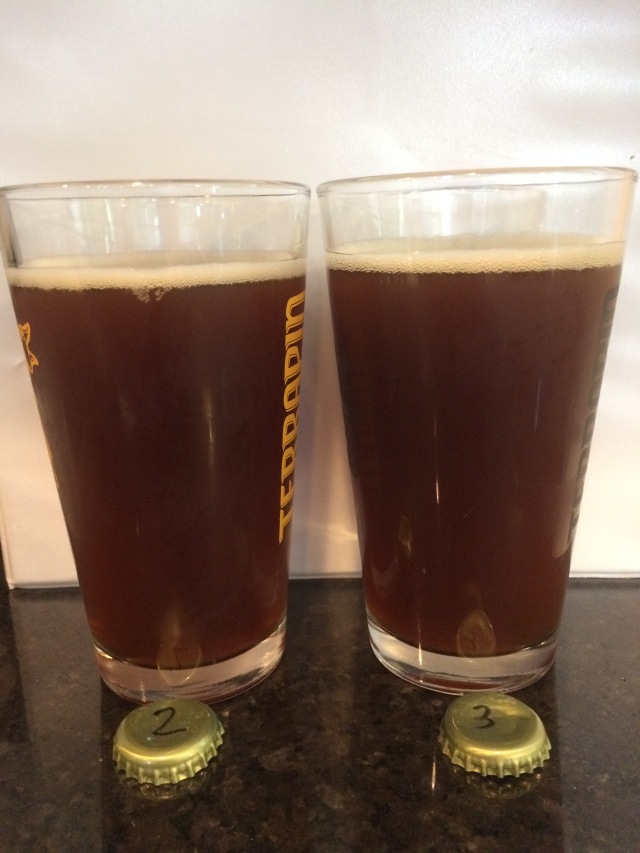This post is one in a series of making small adjustments to a single recipe in order to improve it, learn more about the impact each ingredient has on the finished product, and the art of recipe creation. The rest of the comparison tastings in this series can be found here.
I’m finding these side by side tastings to be a battle against preconceived notions. Still, knowing what I think of each going into the comparison, gauging which beer is closer to my end goal is the most important piece. In the three tastings I’ve done, I’ve found this to be the most useful aspect. That said, each time I’ve done this, I have somehow managed to taste and note certain aspects that I hadn’t noticed before (e.g., the red cherry flavor I note below).
I realize that this method is flawed to some extent. Age of each beer plays a factor (as I’ve noted before), and my preconceived notions of each beer definitely come into play (as I mentioned above). I have yet to do a triangle test with these beers or taste them blind, and I probably should. Now, with that obligatory “I know what I’m doing has shortcomings” out of the way, let’s begin.
Recap
The full recipes for Iteration 2 and Iteration 3 of this red IPA can be found in the links, but the differences between these beers were:
- Iteration 2 used 1 lb. of C120
- Iteration 3 used 0.75 lbs. of C120 and 0.5 lbs. of Special B
- Iteration 3 used 0.25 lbs. more grain
- Iteration 2 clocked in at 7.1% ABV, while Iteration 3 was a 6.3% beer
The difference in ABV was unintentional and a factor of gathering more pre-boil wort than intended. This, of course, also indicates a difference of 8 points in the OG. Iteration 2 also finished 2 points higher than number 3, but still at a nice and dry 1.010.
Appearance
The appearance of each was strikingly similar, and I immediately placed the labeled caps beside each glass to avoid confusing them. Both had a moderate head and decent retention. If I looked closely enough, though, beer 2 had a touch of orange in its mostly red hue, whereas beer 3 was a definite dark red. This difference was easier to note as the amount of beer in each glass lessened, but I would certainly call both red in color.

Left: Iteration 2|Right: Iteration 3
Aroma
Iteration 2 had citrus and a hint of malt sweetness to the nose, although I can’t be sure that the “sweetness” I smelled wasn’t actually the beginning of oxidation. I suppose time will tell when I compare this beer to the next version of this recipe.
My first impression this time with Iteration 3 was that of an orange citrus aroma. This isn’t something I’d noticed before with this beer, but I decided to trust my nose that day instead of letting what I’d experienced before influence my perceptions (for good or bad). There were also some dark cherry notes in the nose.
Flavor
The taste of Iteration 2 started with a citrus flavor that faded into red cherry maltiness. I noticed that there was no lingering bitterness to this beer.
Beer 3 had citrus and floral notes up front that faded into a mix of floral, raisin, and dark cherry flavors. The raisin lingered, mixed with floral bitterness.
Final Thoughts
Iteration 2 is definitely closer to the end goal of this recipe. It has a certain brightness to the citrus flavor, but it also has that dark fruit flavor I want from the malt. I stand by my previous assertion that more complexity and more of the dark fruit character should get this malt bill where it needs to be. I also maintain that with Iteration 3, the raisin muddies the flavor and detracts from an otherwise good beer.
After I set down my pen and started doing other things, I still had two, mostly full pint glasses in front of me. I took sips from each in a mostly indiscriminate way, sometimes paying attention to which one I was drinking and sometimes not. Perhaps it was just the nature of drinking two beers on an empty stomach (probably in the amount of time I’d normally drink one, just because they were both there in front of me), but it became harder to tell the difference between them. I could still distinguish them some due to the raisin flavor, but even that seemed less prevalent than when I was scrutinizing these beers. Unfortunately, my wife wasn’t home, so I didn’t have anyone to pour a triangle test for me. That means I couldn’t see if the difference was really more subtle than I’d thought before or if I was just a little tight.
As I did last time, I blended these two beers once half of each was gone. The resulting mix was malty and raisiny up front, attesting to the strength of Special B’s flavor. The malt flavor then faded to citrus. This order of flavor prominence was odd to me since, in both beers individually, I got the hop character up front followed by a fade into maltiness. The blended beer flipped that order. I really can’t imagine why, and I have no guesses. The blend does tell me, though, that I’m making the right decision in eliminating Special B from my grist.
